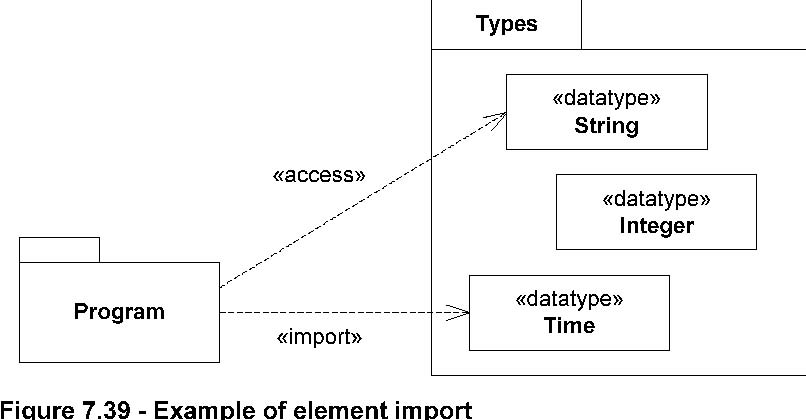*Generalizations
•
DirectedRelationship (from Kernel ) on page 62
Description
An element import is defined as a directed relationship between an importing namespace and a packageable element. The name
of the packageable element or its alias is to be added to the namespace of the importing namespace. It is also possible to
control whether the imported element can be further imported.
Attributes
Issue 9191 - add default value
• visibility: VisibilityKind Specifies the visibility of the imported PackageableElement within the importing Package. The default visibility is the same as that of the imported element. If the imported element does not have a visibility, it is possible to add visibility to the element import. Default value is public.
• alias: String [0..1] Specifies the name that should be added to the namespace of the importing Package in lieu of the name of the imported PackagableElement. The aliased name must not clash with any other member name in the importing Package. By default, no alias is used.
Associations
• importedElement: PackageableElement [1] Specifies the PackageableElement whose name is to be added to a Namespace . Subsets DirectedRelationship ::target.
• importingNamespace : Namespace [1] Specifies the Namespace that imports a PackageableElement from another Package. Subsets DirectedRelationship ::source and Element::owner.
Constraints
[1] The visibility of an ElementImport is either public or private.
self.visibility = #public or self.visibility = #private
[2] An importedElement has either public visibility or no visibility at all.
self.importedElement.visibility.notEmpty() implies self.importedElement.visibility = #public
Additional Operations
[1] The query getName() returns the name under which the imported PackageableElement will be known in the importing namespace.
ElementImport ::getName(): String;
getName =
if self.alias->notEmpty() then
self.alias
else
self.importedElement.name
endif
Semantics
An element import adds the name of a packageable element from a package to the importing namespace. It works by reference,
which means that it is not possible to add features to the element import itself, but it is possible to modify the referenced
element in the namespace from which it was imported. An element import is used to selectively import individual elements without
relying on a package import.
In case of a name clash with an outer name (an element that is defined in an enclosing namespace is available using its unqualified
name in enclosed namespaces) in the importing namespace, the outer name is hidden by an element import, and the unqualified
name refers to the imported element. The outer name can be accessed using its qualified name.
Issue 8079 -Clarify meaning of import when there are name clashes.
If more than one element with the same name would be imported to a namespace as a consequence of element imports or package
imports, the elements are not added to the importing namespace and the names of those elements must be qualified in order
to be used in that namespace. If the name of an imported element is the same as the name of an element owned by the importing
namespace, that element is not added to the importing namespace and the name of that element must be qualified in order to
be used.
An imported element can be further imported by other namespaces using either element or package imports.
The visibility of the ElementImport may be either the same or more restricted than that of the imported element.
Notation
An element import is shown using a dashed arrow with an open arrowhead from the importing namespace to the imported element.
The keyword «import» is shown near the dashed arrow if the visibility is public, otherwise the keyword «access» is shown to
indicate private visibility.
If an element import has an alias, this is used in lieu of the name of the imported element. The aliased name may be shown
after or below the keyword «import».
Presentation options
If the imported element is a package, the keyword may optionally be preceded by element, i.e., «element import».
As an alternative to the dashed arrow, it is possible to show an element import by having a text that uniquely identifies
the imported element within curly brackets either below or after the name of the namespace. The textual syntax is then:
‘{element import’ <qualified-name> ‘}’ | ‘{element access ’ <qualified-name> ‘}’
Optionally, the aliased name may be shown as well:
‘{element import ’ <qualified-name> ‘ as ’ <alias> ‘}’ | ‘{element access ’ <qualified-name> ‘as’ <alias> ‘}’
Examples
The element import that is shown in Figure 7.39 allows elements in the package Program to refer to the type Time in
Types without qualification. However, they still need to refer explicitly to Types::Integer, since this element is not imported.
The Type string can be used in the Program package but cannot be further imported from that package.

In
Figure 7.40
, the element import is combined with aliasing, meaning that the type Types::Real will be referred to as Double in the package
Shapes.
